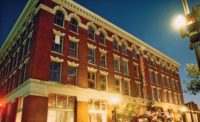When the five-story Sazerac House opens in downtown New Orleans next spring, it will pay homage to one of the city’s most iconic cocktails while reviving an 1850s-era building that’s been vacant for more than three decades.
To pull that off, contractors must carefully coordinate the multiple complexities of a historic restoration, an interactive exhibit space and small-scale production components.
“It’s really three projects in one,” says David Barbier, vice president of preconstruction for Ryan Gootee General Contractors, contractor on the project.
The 48,000-sq-ft space will include three floors of interactive exhibit space that include creating virtual cocktails, with self-guided tours to explore the history of the Sazerac cocktail and New Orleans’ influence on cocktail culture.
The cocktail of whiskey, bitters, sugar and absinthe dates back to 1838 and New Orleans apothecary owner Antoine Peychaud, who is credited with creating the cocktail as a brandy toddy that featured his family recipe for “Peychaud’s Bitters.” The Sazerac is considered the first “branded” cocktail and the reason why the word “cocktail” exists, as Peychaud measured the toddies with a double-ended egg cup, known as a “coquetier.”
The building will house an event space on the fourth floor and offices on the fifth floor for up to 60 employees of the Sazerac Co., the locally-based spirits company that owns the building.
Each phase of the building has a different design professional, Barbier says, and the contractor has had to work with multiple team members and various designers.
Because of the complexity of the project, the construction team relied on a design-assist delivery that involved regular meetings with the owners, designers, consultants and subcontractors. The team also used 3D building information modeling (BIM) to more efficiently coordinate construction and design. Historic preservation architects Trapolin-Peer Architects designed the project.
Work began in late 2017 and is about 50% complete.
Peeling Back the Layers
The Sazerac House consists of two adjoined buildings, at 500 and 510 Canal St., that the Sazerac Co. bought from the adjacent Sheraton Hotel. Throughout their existence, the buildings had been used for various purposes, including as a haberdashery and storage for the Sheraton.
Because the buildings sat vacant for so long, they were in a state of disrepair.
During initial inspections, engineers uncovered significant termite damage and wood rot, extensive roof leaks and overall neglect. The exterior walls had settled significantly, possibly during construction of the Sheraton in the 1980s, says Jamie Saxon, president and partner with Morphy Makofsky, the structural engineer on the project.
A 3D scan of the building was used as the basis for the design model. A side component of the scan revealed that each floor of the building was not level. On average, the 500 Canal St. building was about 7.5 in. out of level, and the 510 Canal St. building was 9.5 in. off, Barbier says.
When contractors started cleaning out and shoring up the building, further signs of its deterioration surfaced. Much of the damage had been hidden behind framing before crews removed the plaster finishes and partition walls.
“Until that was all cleared out, we didn’t know half of the problems that existed in the building,” Saxon says.
Engineers uncovered evidence that the building had undergone partial demolition and rebuilding at least two or three times, including some time in the 1920s. “It’s hard to piece together exactly what happened and when it happened,” Saxon says.
Further complicating the restoration was finding that the 510 Canal St. building’s roof had been leaking for more than 35 years. During Hurricane Katrina, the roof had lifted up, then collapsed. Temporary shoring was put in place to hold it up, explains Cynthia Dubberley, senior associate with Trapolin Peer.
“We had to take this temporary shoring that had been in place since Katrina and actually fix it, which meant re-creating some of the columns and replacing some of the beams,” she says.
Historic Restoration
The Sazerac Co. has a history of purchasing and restoring older buildings, but Sazerac House holds special significance because it’s a few blocks from the original Sazerac Coffee House, the French Quarter establishment where the cocktail was popularized in the 1850s.
“Being on Canal Street was very important to us, and with the location being just a few hundred yards from the original Sazerac Coffee House, which was on Exchange Alley, it just seemed like a perfect fit,” says Amy Preske, Sazerac spokeswoman.
Wood floors, high ceilings, oversized windows and ornate support columns are among the building’s architectural details, and contractors have been working to preserve as many of the original design elements as possible.
“Being on Canal Street was very important to us, and with the location being just a few hundred yards from the original Sazerac Coffee House ... it just seemed like a perfect fit.”
– Amy Preske, Sazerac Co. spokeswoman
Older structures present their share of challenges, though. For example, in July a whiskey storage warehouse Sazerac owns in Louisville, Ky., collapsed. The structure dated back to the 1940s.
To ensure the stability of the Sazerac House, given its deteriorated state, contractors, engineers and architects went to great lengths to inspect, repair and fortify the structures.
“The primary task was to stabilize the building,” Barbier says.
To restore the masonry walls, the contractor used a low-pressure mortar injection specifically formulated to replace historic grout and stabilize masonry. The grout is injected into the matrix of the walls to reinforce them.
Grouted hollow rods were used to bind masonry walls that had separated over the years, and helical ties were used to stitch cracks, Barbier explains.
The front portion of the façade had been rebuilt at some point in the buildings’ history but had worn down over time. The architect was able to take historic photos of the buildings and re-create some of the details and elements original to the structures.
Because of the historic nature of the wood-framed buildings, the contractor had to use materials compatible with the existing structure. “We couldn’t change out the wood framing to steel framing in areas that were previously wood-framed,” Saxon says. Because the wood was close to 100 years old, it was stronger than modern wood framing. Engineers had to determine the strength of the existing materials and locate wood that was compatible in strength and size. “The existing framing was older, heart pine—much better quality than the wood we get today,” Saxon says.
The buildings that will make up the Sazerac House are locally landmarked by the city of New Orleans’ Historic District Landmarks Commission. Developers had sought tax credits to develop the building, which meant architects and others had to obtain permits and approvals on local, state and federal levels.
Plans for the Sazerac House called for a rooftop penthouse, but stipulations in the historic tax credits placed height limits on the penthouse addition and roof-mounted equipment.
Architects had to appeal the state’s decision to reject the penthouse design and show local jurisdictions how much of the penthouse would be visible downtown. The architects ultimately won the appeal on the condition that they slightly reduce the size of the penthouse.
The “Wow” Factor
Exhibit space is central to the Sazerac House, and designers worked to create a visually striking and impressive area for visitors. The focal point of the space is a three-story, glass-encased display wall used to showcase various Sazerac bottles. The backlit display will serve as a backdrop for a monumental staircase that connects the exhibit floors. “That will really be the ‘wow’ moment when you first come in,” Dubberley says.
The display wall is made of structural-steel supports, some of which were unique fabrications designed by the engineers.
The staircase itself incorporates wood salvaged from the building. The guardrails will have steel, laser-cut panels and cutout designs of the ‘S’ inspired by the Sazerac bottle.
The exhibit space also will feature state-of-the-art touch-screen AV systems. “From the time they started the concept in April 2016 to today, the AV systems have changed and been updated with more modern equipment,” Barbier says.
The designers’ intent was to expose the historic wood columns and beams in the exhibit spaces, so sprinkler and ductwork mains were designed to fit in a soffit surrounding the monumental staircase opening on each floor. However, there was insufficient space to add infrastructure—such as ductwork, utilities and sprinkler lines—between the finished acoustic wood ceiling and the fire-rated ceiling at the underside of the wood floor joists.
Contractors came up with the idea to run all the distribution lines within the floor joists above the fire-rated ceiling. That allowed the architect to raise the finished ceiling high enough to expose the wood beams and meet the design intent.
Problem Solving
Because the project called for adding a floor and a half for the penthouse, engineers had to consider the building’s previous uses and load strength. “We reviewed the existing footings to make sure they were in good condition and still usable,” Saxon says.
Contractors needed to extend the load-bearing masonry walls above existing walls to support the steel framing for the penthouse. To accomplish this, the contractor used autoclave-aerated concrete (AAC) blocks—lightweight concrete blocks that provide a four-hour fire rating and weigh about 40% of what a regular concrete block weighs.
“That’s kind of a unique material—a difficult material for a contractor to construct with,” Saxon says.
Builders used similar AAC concrete planks—prefabricated concrete planks—for floors and areas such as the mezzanine to meet fire and load-rating requirements.
The building’s downtown location meant the construction team would have to meet the city’s requirements that all electrical systems be explosion-proof. That meant specifying components such as light fixtures and outlets in high, hard-to-reach areas to meet code requirements.
The construction team also had to innovate to comply with the city’s stormwater management plan. Normally, builders address this by using permeable pavers or adding a rain garden, Dubberley says. Instead, builders installed two massive storage tanks under the 500 Canal St. building’s slab to temporarily hold stormwater from big rains.
Barbier says the project’s multiple components and complexities are what set it apart and will make for a one-of-a-kind finished product.
“I don’t know if there are any comparable projects to this, that combine a historic restoration/renovation project with a fully operational micro-distillery all set in a world-class museum space,” Barbier says. “There are none in this area that I know of.”
The Sazerac House is scheduled for completion by April 2019, with an opening shortly after that.









